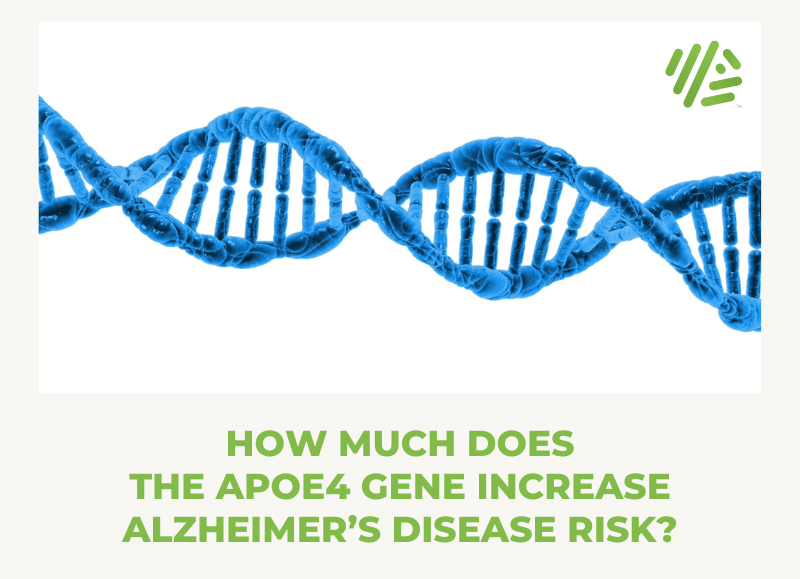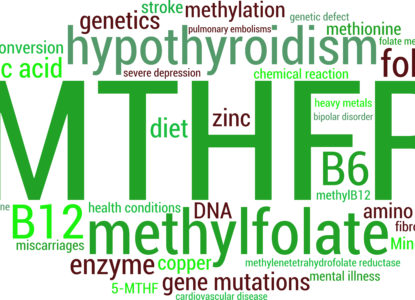How Much Does the ApoE4 Gene Increase Alzheimer’s Disease Risk?
Article at a Glance
- Those carrying two copies of APOE3 have a neutral risk of 1.
- A single APOE4 allele increases this risk up to 4.4, and two copies of APOE4 increase this to 19.3!
- A single copy of APOE2 reduces the risk down to 0.3, and can mitigate for an APOE4 allele, effectively keeping the risk-neutral (1.1)
Genes Mentioned

Contents
Alzheimer’s disease is the most notorious form of dementia, with dementia being defined as “a series of conditions occurring when nerve cells or neurons in the brain die or no longer function as they should.” These changes will impair a person’s ability to carry out basic daily life activities, and even more, Alzheimer’s will also affect one’s memory, behavior, and the ability to think clearly.1
In this post, we discuss the APOE gene, and how much carrying one or two copies of ApoE4 increases the risk for developing Alzheimer’s.
What causes Alzheimer’s disease?
The progression of Alzheimer’s is relatively well understood, with regions of the brain shrinking (displaying atrophy) and the growing formation of amyloid plaques, protein rich deposits which impair neuronal activity. Neurofibre tangle formation, alterations in levels of the neurotransmitter acetylcholine, and vascular changes in the brain limiting blood flow are also hallmarks of the progression of the disease.
Over time these structural changes spread throughout the brain, with the regions responsible for memory being hardest hit.
What we don’t know is why this happens in some people, but not others, but there are several risk factors.
Age increases risk for Alzheimer’s
Although the food we eat plays a role, age is the most significant factor related to the development of Alzheimer’s disease.
The risk of developing the disorder doubles every 5 years beyond 65 years of age.
However, approximately 1 in 20 individuals will develop Alzheimer’s before the age of 65, with this form of the disease termed “early onset Alzheimer’s.” This version of dementia has a very strong genetic element through three different genes (APP, PSEN1 and PSEN2) and affected families are often well aware of the familial risk.
Of course, there are other genetic factors which can predispose people, which we’ll get into below.
Lifestyle and heart disease
A major focus in recent years has been the link between cardiovascular diseases and the onset of Alzheimer’s/dementia. The brain is an incredibly resource intensive organ needing a continuous supply of oxygen and other nutrients to function correctly. Major blockages in blood flow to the brain will lead to a stroke, but long term “low grade” reductions are also associated with poor health outcomes. 2
It has been estimated that at as many as one third of Alzheimer’s cases world wide are caused by 5 risk factors, most of which are tied to lifestyle / heart health and can be prevented.3
The big ones are:
- smoking
- hypertension
- obesity
- diabetes;
- and physical inactivity
Note: If you participate in daily exercise, it will help improve cognitive function and reduce the formation of amyloid plaques, especially among ApoE4 carriers. 4
The APOE gene and Alzheimer’s risk
The genetic basis of early onset Alzheimer’s is controlled relatively tightly with a strong familial association.
However, there is another genetic polymorphism which has been shown to correlate with Alzheimer’s risk in the general population, APOE.
APOE encodes for the most prevalent of the brain’s lipoproteins, apolipoprotein E.
These proteins function to transport lipids throughout the body, as lipids are normally insoluble in water (think of the fat droplets that form in your sink when washing a pan), and are therefore difficult for cells to absorb. Lipids are essential for proper cell growth and maintenance, and the brain, as a major site of cell development, requires a steady supply.
Interestingly, APOE also functions to clear the beta-amyloid protein — Aβ — in the brain, which is a component of the plaques associated with Alzheimer’s.5
APOE ε2, APOE ε3, and APOE ε4
There are common variants in the APOE genes which change the risk for Alzheimer’s disease. There are actually three distinct forms of APOE genetics which can be produced termed APOE ε2, APOE ε3, and APOE ε4 (from now on we’ll just say APOE2, 3 or 4).
These “isoforms” are important as they have been shown to carry differing risk for the development of Alzheimer’s and also the resulting rate of cognitive decline.56
The APOE3 form is the most frequent in all populations and is considered to be the neutral form. Interestingly, APOE2 is protective for the development and progression of Alzheimer’s, although it is relatively rare, and is associated with an increased risk for some cardiovascular disorders. Conversely, E4 is associated with an increased risk for Alzheimer’s disease, a more severe progression and also an increased risk of developing other neurological disorders.
It is, however, important to note that there is not a 100% association with any of these isoforms. Carrying the ApoE4 isoform does not mean you will develop Alzheimer’s, rather that you are at an increased risk compared to the general population, and there are lifestyle changes you can make to reduce this risk. 7 8
How to tell if you have ApoE4
There are two SNPs which can be used to identify your APOE isoform C526CT or rs7412 and T388C or rs429358. The combinations and which isoform they produce (and the percentage occurrence in the population) are shown in the table below.
| T388C - rs429358 | |||
| T | C | ||
| C526T - rs7412 | C | 3 (79%) | 4 (14%) |
| T | 2 (7%) | Unknown as so rare. | |
It is important to remember that the above table gives you your isoform for a single allele, you will however carry two copies so it’s important to work this out for both variants as the risk varies widely as you can see in the table below.9
APOE risk
| APOE Genotype | 2:3 | 3:3 | 2:4 | 3:4 | 4:4 |
|---|---|---|---|---|---|
| Odds Ratio | 0.3 | 1 | 1.1 | 4.4 | 19.3 |
As you can see those carrying two copies of APOE3 have a neutral risk of 1.
A single APOE4 allele increases this risk up to 4.4, and two copies of APOE4 increase this to 19.3!
The protective effect of the APOE2 allele can also be seen, a single copy of APOE2 reduces the risk down to 0.3, and can mitigate for an APOE4 allele, effectively keeping the risk neutral (1.1). 9
The bottom line
Is Alzheimer’s a genetic disease, or can it be controlled by following a healthy lifestyle?
Both.
Carrying two copies of ApoE4 increases risk by 19 times. Clearly genetics play a role.




I am a member of the Apoe4.info community and have heard about APOE 2/4 being protective, even a study looking at conversion of 4 to a 2 is underway. My grandmother, father and sister all have APOE 2/4 and either have died or are dying of AD. My sister was diagnosed age 57. She was a MD and very fit, ate very carefully, plant based with some occasional meat and no sugar. She does not have early onset genes. My mother died of AD also and was 3/4, as I am. I don’t expect any sort of answer to my anecdotally based question based on one family, but I did want to put it out there that some people die of AD with Apoe2 /4. I suspect there must be other genes involved. Any comment appreciated.